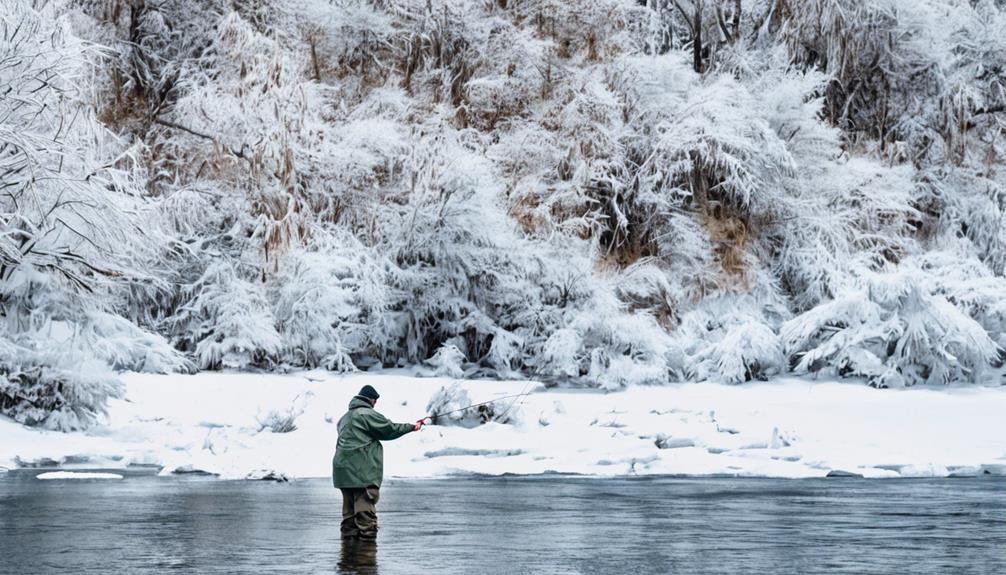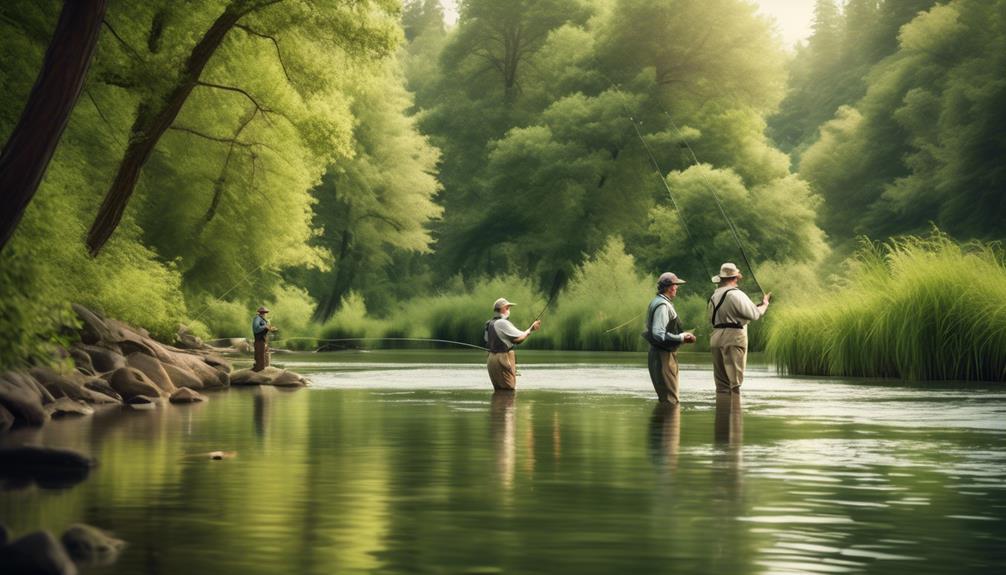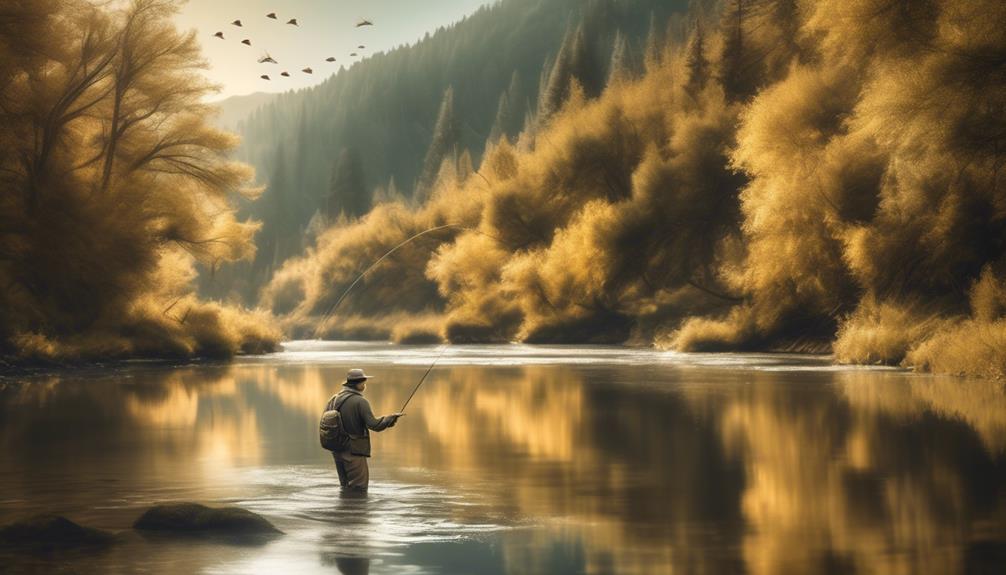When it comes to winter fly fishing, your gear is more than just equipment; it's your shield against the biting cold and your key to unlocking the secrets of icy waters. Proper winter fly fishing gear is essential for not only your comfort but also for your success on the water.
But why exactly is it so crucial? Well, imagine standing knee-deep in a freezing river, surrounded by snow-covered banks, with only your regular fishing gear to rely on. How would you cope? What could go wrong? You might be surprised to learn just how much of a difference the right winter gear can make.
Insulated Waders
When gearing up for winter fly fishing, insulated waders are essential to keep you warm and comfortable in cold water conditions. The right gear can make all the difference, and insulated waders provide the necessary protection against icy waters. Pairing them with thermal socks ensures that your feet stay toasty, allowing you to focus on the thrill of the catch rather than shivering in discomfort.
As you navigate the frigid waters, waterproof gloves are another crucial component of your winter fly fishing gear. These gloves not only keep your hands dry but also provide insulation, safeguarding against the numbing effects of the cold. With the combination of insulated waders, thermal socks, and waterproof gloves, you can confidently wade into the icy streams and fully immerse yourself in the serenity of winter fly fishing.
Investing in high-quality insulated waders is a game-changer for any winter angler. These waders are designed to keep you warm and dry, allowing you to extend your fishing season well into the colder months. Coupled with thermal socks and waterproof gloves, they form a formidable barrier against the elements, ensuring that you can focus on the joys of fishing without being hindered by the harsh winter conditions.
Warm Layering System
To further enhance your winter fly fishing gear, incorporating a warm layering system is essential for maintaining your body heat and comfort in cold weather conditions. When preparing for a winter fly fishing trip, consider the following items to ensure you stay warm and comfortable throughout your excursion:
- Thermal socks: Keeping your feet warm is crucial, and thermal socks provide insulation and moisture-wicking properties to keep your feet dry and toasty. Look for options specifically designed for outdoor activities to ensure maximum warmth and comfort.
- Heated gloves: Investing in heated gloves can make a significant difference in keeping your hands warm and dexterous while out on the water. These gloves are designed to provide continuous warmth, allowing you to focus on fishing without the discomfort of cold hands.
- Waterproof boots and fleece jackets: Waterproof boots are essential to keep your feet dry and insulated from the cold. Pair them with fleece jackets, which offer excellent warmth and breathability. Fleece jackets are lightweight and allow for freedom of movement, making them ideal for layering in cold weather.
Winter-Weight Fly Rod
For winter fly fishing, ensure you have a fly rod with a suitable weight for handling the challenges of cold weather conditions and potential heavier flies. A winter-weight fly rod becomes essential for winter casting, as the weight of the rod affects the ease of casting, especially when dealing with heavier lines and flies in colder temperatures.
A winter-weight fly rod typically falls within the 6 to 8 weight range, providing the necessary backbone to handle larger flies and the flexibility to cast them with precision. In winter, fish tend to be more lethargic and are often found in deeper, slower-moving water. A heavier rod enables you to make accurate and longer casts, reaching these elusive pockets where fish may be holding.
Additionally, a winter-weight fly rod offers the flexibility needed to perform various casting techniques, crucial for adapting to the constantly changing conditions of winter fishing. The rod's flexibility allows for delicate presentations when required, while still possessing the strength to control larger fish in challenging winter conditions.
When selecting a winter-weight fly rod, consider the type of water you'll be fishing in and the species you'll be targeting. A well-balanced rod will enhance your overall fishing experience, providing the power and finesse needed for successful winter fly fishing.
Coldwater Fly Lines
Consider selecting a coldwater fly line designed to handle the unique challenges of winter fishing, ensuring optimal performance in colder temperatures and varying water conditions.
When it comes to coldwater fly lines, there are a few key factors to keep in mind for a successful winter fly fishing experience:
- Temperature regulation: A quality coldwater fly line is specifically engineered to remain supple and manageable in colder temperatures. This feature is essential for preventing line coiling and tangles, allowing for smooth and effortless casting even in chilly conditions.
- Line maintenance: Coldwater fly lines are designed to resist icing up, which can be a common issue when fishing in colder temperatures. By choosing a coldwater-specific line, you can minimize the need for constant de-icing and cleaning, ensuring that your line remains in top condition throughout your winter fishing adventures.
- Durability: Winter fishing conditions can be harsh on equipment, so selecting a durable coldwater fly line is crucial. Look for lines with reinforced coatings and enhanced toughness to withstand the rigors of coldwater fishing, including potential encounters with ice and rough underwater terrain.
Ice-Proof Fly Reels
When it comes to winter fly fishing, the durability and resistance to icing up that you value in your coldwater fly line should also be sought after in your ice-proof fly reels. Ice fishing presents unique challenges, and having the right equipment is crucial for success. In winter fishing techniques, ice-proof fly reels are essential in preventing ice buildup, which can hinder the functionality of traditional fly reels. These specialized reels are designed with sealed drag systems and corrosion-resistant materials to withstand extreme cold and prevent ice from accumulating. This ensures that your reel operates smoothly, allowing you to focus on your winter fishing techniques without interruptions.
Ice-proof fly reels often feature larger arbors, which prevent the line from coiling in cold conditions, and larger handles that accommodate gloved hands. These features make it easier to handle the reel in freezing temperatures, improving overall performance and comfort during winter fishing. Additionally, some models come with extended stems and larger drag knobs for quick and easy adjustments while wearing gloves.
When selecting an ice-proof fly reel, consider the environment in which you'll be fishing and the species you're targeting. Look for reels with quality construction and reliable drag systems to handle the demands of ice fishing. By investing in an ice-proof fly reel, you can enhance your winter fly fishing experience and ensure that your equipment performs optimally, even in the harshest conditions.
Hand-Warming Gear
To combat the numbing chill of winter fly fishing, outfit yourself with hand-warming gear designed to keep your hands comfortable and dexterous in the coldest conditions.
When it comes to winter fly fishing, keeping your hands warm is essential for an enjoyable and successful angling experience. Here are some hand-warming techniques and gear options to consider:
- Pocket Hand Warmers: Invest in reusable pocket hand warmers that can provide steady warmth for hours. These compact heat sources are easy to carry and can be a lifesaver when the temperature drops.
- Thermal Gloves: Opt for thermal gloves specifically designed for fishing. Look for gloves that offer both warmth and dexterity, allowing you to tie knots and handle your gear without having to remove them constantly.
- Hand Warming Techniques: Practice simple hand-warming techniques such as rubbing your hands together vigorously or tucking them into your armpits for a quick warmth boost. These techniques can provide immediate relief when you're out on the water and need to thaw out your hands.
Specialized Winter Flies

In winter fly fishing, selecting specialized winter flies tailored to the feeding patterns of cold-water fish is crucial for maximizing your chances of a successful catch. Winter fly patterns are designed to mimic the insects and other aquatic life that are active in cold water, making them essential for enticing fish during the colder months. When it comes to fly selection for coldwater fishing, it's important to consider the natural prey available to fish in winter and match your flies accordingly.
Coldwater fishing techniques require a thoughtful approach to presentation strategies. During winter, fish tend to be less active and may not move far to take a fly. As a result, using smaller, more natural-looking winter fly patterns can be highly effective. Flies that imitate midges, small stoneflies, and nymphs are often successful choices. Additionally, fishing with slower retrieves and allowing the fly to sink deeper can better mimic the behavior of the insects fish are feeding on in cold water.
When choosing winter flies, opt for patterns that have a natural coloration and incorporate materials that provide a realistic movement in the water. This can include flies with subtle flash or those that incorporate soft materials like marabou. By carefully selecting winter flies and employing coldwater presentation strategies, you can increase your chances of a successful winter fly fishing experience.
Safety Essentials
Make sure you have the necessary safety essentials before embarking on your winter fly fishing excursion. Winter fishing comes with its own set of risks, and it's crucial to prioritize safety to fully enjoy your experience on the water.
Safety Essentials for Winter Fly Fishing
- Frostbite prevention
Winter fishing exposes you to the risk of frostbite, especially in extremities like your hands and feet. Invest in high-quality insulated gloves and waterproof boots to keep your hands and feet warm and dry. Additionally, consider hand and foot warmers to maintain adequate circulation and prevent frostbite.
- Layered clothing
Dressing in layers is essential to regulate body temperature and prevent hypothermia. Wear moisture-wicking base layers, insulating mid-layers, and a waterproof outer layer to stay warm and dry. Don't forget to protect your head and neck with a thermal hat and a scarf or neck gaiter.
- Hypothermia risks
Understand the signs of hypothermia and be prepared to act if you or your fishing companions show symptoms. Carry emergency blankets, a first-aid kit, and a thermos with a hot beverage to help warm up anyone experiencing the effects of prolonged exposure to cold temperatures.
Prioritizing safety ensures that you can fully enjoy the tranquility of winter fly fishing without unnecessary risks. Stay warm, stay dry, and stay safe out there!
Frequently Asked Questions
Can I Use My Regular Waders for Winter Fly Fishing, or Do I Need Insulated Waders?
You'll need insulated waders for winter fly fishing to stay warm in cold water. Regular waders won't provide enough insulation. It's important to consider wader options and prioritize gear maintenance for a comfortable and successful winter fishing experience.
How Should I Layer My Clothing for Winter Fly Fishing to Stay Warm Without Overheating?
When layering for winter fly fishing, start with thermal socks and base layers to keep warm. Add windproof gloves and a fleece jacket to protect from the cold. This combination will help you stay warm without overheating.
What Makes a Fly Rod Specifically Designed for Winter Fishing Different From a Regular Fly Rod?
When it comes to a winter fly rod, the technology is designed for cold weather conditions. It's made to handle specialized winter fly casting techniques and has features like improved sensitivity and flexibility for better performance in colder temperatures.
Are There Specific Types of Fly Lines Designed for Coldwater Conditions, and How Do They Differ From Regular Fly Lines?
Coldwater fly lines are specifically designed for winter fly fishing. They offer better performance in cold conditions, with advantages like reduced memory and enhanced flexibility. To maintain them, clean and store them properly to extend their lifespan.
What Features Should I Look for in an Ice-Proof Fly Reel for Winter Fly Fishing?
When choosing an ice-proof reel for winter fly fishing, look for sealed drag systems, corrosion-resistant materials, and easy maintenance. Select a rod designed for cold conditions, and consider shorter lengths and fast-action tips for precision casting in winter.
Conclusion
So, as you can see, having the proper winter fly fishing gear is essential for staying comfortable and safe on the water.
Insulated waders, a warm layering system, winter-weight fly rod, coldwater fly lines, ice-proof fly reels, hand-warming gear, specialized winter flies, and safety essentials will all contribute to a successful and enjoyable winter fly fishing experience.
Don't let the cold weather deter you from pursuing your passion – just make sure you're properly equipped!



